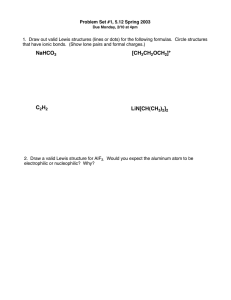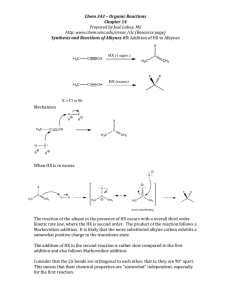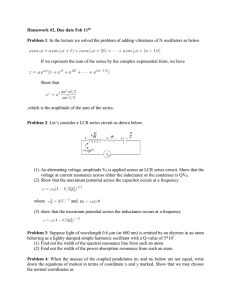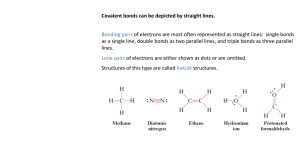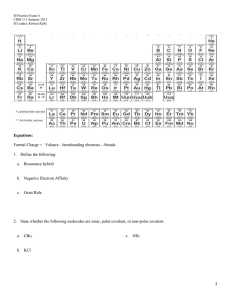Representing Change in Elec . Configuration Curved Arrow Notation
advertisement
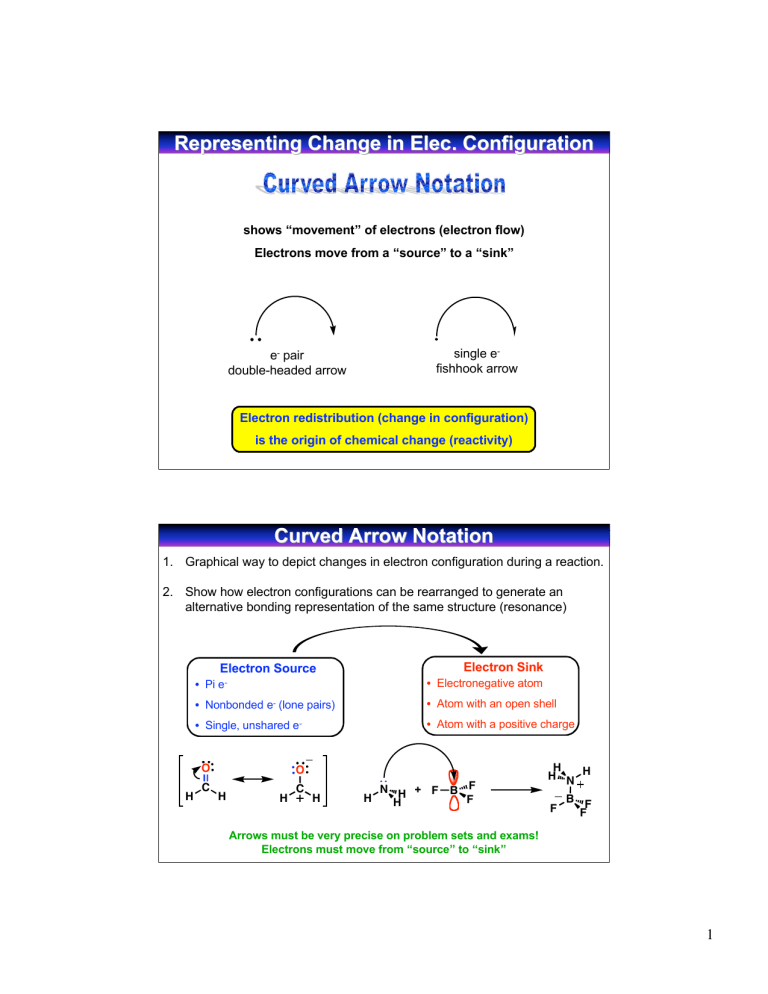
Representing Change in Elec. Elec. Configuration shows “movement” of electrons (electron flow) Electrons move from a “source” to a “sink” single efishhook arrow e- pair double-headed arrow Electron redistribution (change in configuration) is the origin of chemical change (reactivity) Curved Arrow Notation 1. Graphical way to depict changes in electron configuration during a reaction. 2. Show how electron configurations can be rearranged to generate an alternative bonding representation of the same structure (resonance) Electron Sink Electron Source • Pi • Electronegative atom e- • Atom with an open shell • Nonbonded e- (lone pairs) • Single, unshared O H C • Atom with a positive charge e- O H H C H H N H + F H B F F H H N H F B F F Arrows must be very precise on problem sets and exams! Electrons must move from “source” to “sink” 1 Describing Resonance with Curved Arrows Mechanics 1. Nonbonding pair to adjacent bond (vertex-to-edge transfer) A A 2. Bonding pair to an adjacent atom (edge-to-vertex transfer) A A 3. Bonding pair to an adjacent bond (vertex-edge-vertex transfer) A O N O O A N O O N O Notice that the sigma network does not change and the placement of atoms remains the same. Courtesy of Jeffrey S. Moore, Department of Chemistry, University of Illinois at Urbana-Champaign. Used with permission. Adapted by Kimberly Berkowski. Rules for Resonance Structures • Resonance forms are imaginary • They differ only in the placement of pi or nonbonding electrons, atom placement is the same (Electron movement takes place in the pi system, not sigma system) • Must be valid Lewis structures and obey the rules of valency • Difference resonance forms don’t have to be energetically equivalent (Lower energy resonance structures contribute most to overall structure of molecule) • The resonance hybrid (weighted average) is more stable than any individual resonance form • Use a double-headed arrow between structures and brackets around them, keep track of lone pairs and formal charges 2 Using Resonance to Predict Site of Reactivity O H N H lone pair = e- H ? H Where is e- sink? source Look at resonance contributors: e- flow from pi bond to electronegative oxygen H N H H O d- O O H H minor contributor major contributor H H O H H d+ H H Minor resonance contributor suggests that the carbon atom is electron deficient O N H H H Relative Energies of Resonance Contributors O N O O N O dO dN O O N O d- Resonance hybrid: weighted average of resonance contributors Which structure contributes more in resonance hybrid? In other words: which structure is more STABLE (has lower potential ENERGY) ENERGY) Courtesy of Jeffrey S. Moore, Department of Chemistry, University of Illinois at Urbana-Champaign. Used with permission. Adapted by Kimberly Berkowski. 3 Predicting Energies of Resonance Structures Which structure counts more in resonance hybrid? Resonance hybrid: weighted average of resonance contributors In other words: which structure is more STABLE with a lower ENERGY i. Filled octets for second row elements (C, N, O, F) possible for C only to be electron deficient (6 e-) ii. Minimum # of formal charges and maximum number of bonds iii. Negative charge on most electronegative atom (C<N<O) iv. Minimize charge separation, keep formal charges close together H2C N CH3 H2C N CH3 H2C CH3 N CH3 CH3 Major Follows guidelines CH3 Minor Violates i Minor Violates i Predicting Relative Energies A H3C O B C H3C N H3C C O N O C H3C D A: B: C: D: E: C N H3C C O O C N N E follows all guidelines violates ii (2 formal charges) violates ii (2 formal charges) and iii (negative charge on C) violates i (6 e- on C) and ii (2 formal charges) violates i (6 e- on C), ii (2 formal charges), and iv (more charge separation than D Relative energy: A << B < C << D < E Relative contribution to resonance hybrid: A > B > C > D > E 4 Structure and Energy Goal: Determine relative energy of a compound by analyzing it’s structure (high/low) Potential energy Reactivity Stability (high/low) (low/high) Analyzing the energy of a stucture allows you to: • Determine relative energies of resonance contributors • Determine which reaction will proceed faster • Determine position of equilibrium Courtesy of Jeffrey S. Moore, Department of Chemistry, University of Illinois at Urbana-Champaign. Used with permission. Adapted by Kimberly Berkowski. Determining Molecule Stability from Structure Incomplete octet? yes High potential energy Unstable C+ and B Reactive! no Formal charge? yes no Relatively low potential energy Relatively stable Relatively unreactive Consider: Electronegativity Atom size Hybridization Induction Resonance of charged atom Most important parameters in determining stability: 1. Incomplete octet 2. Formal charge 5 Examples of Most Important Parameters Incomplete octet H3C H3C C H CH3 H3C C CH3 CH3 H3C High potential energy Unstable Reactive! CH3 Low potential energy Stable Unreactive Charged vs. Noncharged Positive NH4 vs. Negative NH2 NH3 vs. NH3 More energy Less stable More reactive Stability of Molecules with Formal Charges 1. 2. 3. 4. 5. Electronegativity Atom size Hybridization Induction Resonance Must consider the effect of each parameter for both positive and negative charged atoms Meaningful comparison = only 1 factor varied 6 1. Electronegativity Criteria: atoms in same row and have same # of electron pair domains (Atoms in same row are relatively the same size) For Negative Charges: The more electronegative the atom, the better it can hold a negative charge Electronegativity increases stability (lowers energy) C<N<O<F relative electronegativity -CH < -NH2 < HO- < Frelative stability of charged compounds 3 For Positive Charges: The more electronegative the atom, the worse it can hold a positive charge Electronegativity decreases stability (raises energy) N < O < F relative electronegativity NH4 > H3O > H2F relative stability of charged compounds 2. Atom Size Criteria: atoms in same column and have same # of electron pair domains (Atoms in same column significantly different size) For Negative Charges: The larger the atom, the greater the stability Surplus of electrons, electrons repel each other larger atoms allow this charge to spread out (lowering the charge density) I > Br > Cl > F relative size I- > Br- > Cl- > Frelative stability For Positive Charges: The smaller the atom, the greater the stability Surplus of protons in the nucleus Smaller atoms allow the valence electrons to be held more tightly to the (+) nucleus H H S>O < relative stability S O relative size H H H H 7 Example: N vs O vs S When comparing atoms of different size, size matters more than electronegativity H H H < H3C S < H3C O H H3C N H H H3CH2C S > H > H3CH2C O H3CH2C N H relative stability Nitrogen is most effective at stabilizing a positive charge and least effective at stabilizing a negative charge Sulfur is most effective at stabilizing a negative charge and least effective at stabilizing a positive charge 3. Hybridization sp sp2 sp3 > > 50% s character 33% s character 25% s character The more s character the closer the electrons are held to the (+) nucleus the more electron withdrawing the orbital For Negative Charges: H H H C C > C C H For Positive Charges: > H C C H H H H HC N H < H2C N < H3C N H H H H relative stability H relative stability (-) stabilized by greater s character (+) destabilized by greater s character 1. 1. 2. the electrons are held closer to the (+) nucleus (more stable) more electron withdrawing 2. Energy is decreased! the electrons are held closer to the (+) nucleus - less accessible for bonding to an atom more electron withdrawing Energy is increased! 8 4. Inductive Effects - Electron Withdrawing electronegative atoms draw electron density towards them through the sigma bond network stabilizes (-) charge destabilizes (+) charge stability O H3C H3C O F3C F Cl3C stability C C F O H3C F3C C 5. Resonance The more the charge is spread out (delocalized), the more stable the structure H2C O H2C O H3C O H3C O H3C O O N N N O H2C O stability N O N N N O N stability N 9 Acidity of Organic Molecules Brønsted-Lowry Acid - donates a hydrogen ion (H+) Base - accepts H+ H A + B acid A base + H B conjugate conjugate base acid H-Br Lewis Acid - accepts an electron pair to form a bond (must have empty or easily vacated orbital, or polar bond to a hydrogen) Base - donates an electron pair to form a bond (must have lone pairs to donate) Lewis acid is an “electrophile” it seeks electrons Lewis base is a “nucleophile” it seeks a nucleus H N H + F H Lewis base H H N H B F F F Lewis acid B F F Lewis Acids and Bases Lewis Acid Accepts electron pair if H+ is doing the accepting “acid” if atom other than H+ is doing the accepting “electrophile” Lewis Base Donates electron pair If donates electron pair to H+ “base” If donates electron pair to atom other than H+ “nucleophile” “nucleophilic site” - has electron density to donate “electrophilic site” - wants more electron density 10 Acid Strength ability to donate H+ the stronger the acid, the better able to donate a proton HA + Can act as either acid or base Keq H2O Keq = H3O A HA H2O acidity constant pH when half of the acid molecules are dissociated A Ka = Keq H2O = + H3O Dilute solution [H2O] ~55.6 M (constant) H3O A HA pKa = -log Ka Stronger Acid equilibrium toward right larger Ka smaller pKa weaker (more stable) conjugate base Weaker Acid equilibrium toward left smaller Ka larger pKa stronger (less stable) conjugate base Why should we care so much about pKa? acid-base reactions comprise a major set of reactions in organic chemistry “The key to understanding organic chemical reactions is knowledge of acids and bases.” -Richard F. Daley Learn pKa values on general pKa handout (understand relative values) Understand pKa values on specific pKa handout (for your reference) By knowing a few specific values, you can compare the structure of the compound with a known pKa to predict pKa of an unknown compound 11 Determining Magnitude of Equilibrium O CH3NH2 Keq + H3C base OH O CH3NH3 + conjugate acid pKa = 10.7 acid pKa = 4.8 H3C O conjugate base H+ will always go from the stronger acid to the stronger base O H3C O OH + H+ H3C O pKa = 4.8 CH3NH2 + H+ pKa = 10.7 O H3C CH3NH3 O OH Ka = 10-4.8 + H+ H3C O CH3NH2 + H+ CH3NH3 1/Ka = 1010.7 Keq = Ka x 1/Ka = 105.9 12

